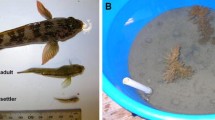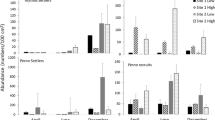Abstract
Pronounced spatial variation in recruitment occurs in many marine invertebrate and fish populations and is thought to be critical to the demography of these species. In this study I examined the importance of habitat structure and the presence of conspecific residents to spatial variation in larval settlement and recruitment in a temperate fish Tautogolabrus adspersus. I define settlement as the movement of individuals from the water column to the benthic habitat, while I refer to recruitment as numbers of individuals surviving some arbitrary period of time after settlement. Experiments in which standard habitats were stocked with conspecifics showed that resident conspecifics were not an important factor contributing to small-scale variability in recruitment. Further correlative analyses demonstrated that large-scale variation in recruitment could not be explained by variability in older age classes. By contrast, manipulations of macroalgal structure within a kelp bed demonstrated that recruitment was significantly higher in habitats with a dense understory of foliose and filamentous algae than in habitats with only crustose algae. Understory algae varied in their pattern of disperison among sites, and the dispersion of fish matched that of the plants. In order to determine the effects of differences in patterns of algal dispersion on the demography of associated T. adspersus populations, I used experimental habitat units to manipulate patterns of dispersion. Settlement was significantly greater to randomly placed versus clumped habitats; however, no differences in recruitment between random and clumped habitats were detected. Because recruitment is a function of the numbers of settlers minus the subsequent loss of settlers, rates of mortality or migration must have been higher in the randomly placed habitats. These results are counter to the current paradigm for reef fishes which suggests that larval settlement is the crucial demographic process producing variability in population abundance. In this experiment patterns of settlement were modified by varying the patch structure of the habitat.
Similar content being viewed by others
References
Addicott JF, Aho JM, Antolin MF, Padilla DK, Richardson JS, Soluk DA (1987) Ecological neighborhoods: scaling environmental patterns. Oikos 49: 340–346
Antonovics J, Levin DA (1980) The ecological and genetic consequences of density-dependent regulation in plants. Ann Rev Ecol Syst 11: 411–452
Auerbach M, Simberloff D (1989) Oviposition site preference and larval mortality in a leaf-mining moth. Ecol Entomol 14: 131–140
Bigelow HB, Schroeder WC (1953) Fishes of the Gulf of Maine. Fishery Bulletin of the Fish and Wildlife Service, vol. 53. U.S. Government Printing Office. Washington. 577 pp
Booth DJ (1991) The effects of sampling frequency on estimates of recruitment of the domino damselfish Dascyllus albisella Gill. J Exp Mar Biol Ecol 145: 149–159
Breitburg DL (1989) Demersal schooling prior to settlement by larvae of the naked goby. Environ Biol Fish 26:97–103
Breitburg DL (1991) Settlement patterns and presettlement behavior of the naked goby, Gobiosoma bosci, a temperate oyster reef fish. Mar Biol 194:231–221
Carr MH (1989) Effects of macroalgal assemblages on the recruitment of temperate zone reef fishes. J Exp Mar Biol Ecol 126:59–76
Chao LN (1972) Digestive system and feeding habitats of the cunner, Tautogolabrus adspersus, a stomachless fish. Fish Bull 71:565–586
Chapman ARO, Johnson CR (1990) Disturbance and organization of macroalgal assemblages in the Northwest Atlantic. Hydrobiologia 192:77–121
Connell SD, Jones GP (1991) The influence of habitat complexity on postrecruitment processes in a temperate reef fish population. J Exp Mar Biol Ecol 151:271–294
DeMartini EE, Roberts DA (1990) Effects of giant kelp (Macrocystis) on the density and abundance of fishes in a cobble-bottom kelp forest. Bull Mar Sci 46:287–300
Dew CA (1976) A contribution to the life history of the cunner, Tautogolabrus adspersus in Fishers Island Sound, Connecticut. Chesapeake Sci 17:101–113
Doherty PJ (1981) Coral reef fishes: recruitment limited assemblages? Proc. 4th Int Coral Reef Symp (Manilla) 2:465–470
Doherty PJ (1983) Tropical territorial damselfishes: is density limited by aggression or recruitment? Ecology 64:176–190
Doherty PJ (1987) The replenishment of populations of coral reef fishes, recruitment surveys, and the problems of variability manifest on multiple scales. Bull Mar Sci 41:411–422
Doherty PJ, Williams D McB (1988) The replenishment of coral reef fish populations. Oceangr Mar Biol Ann Rev 26:487–551
Ebeling AW, Laur DR (1985) The influence of plant cover on surfperch abundance at an offshore temperate reef. Env Biol Fish 12:169–179
Faeth SH (1990) Aggregation of leafminer, Cameraria sp. Nov. (Davis): consequences and causes. J Anim Ecol 59:569–586
Forrester GE (1988) Post-recruitment demographic processes in a coral reef fish: their role in the regulation and determination of population size. Thesis. University of Sydney, Sydney, Australia
Forrester GE (1990) Factors influencing the juvenile demography of a coral reef fish. Ecology 71:1666–1981
Fowler NL (1988) What is a safe site?: Neighbor, litter, germination date, and patch effects. Ecology 69:947–961
Gaines S, Brown S, Roughgarden J (1985) Spatial variation in larval concentrations as a cause of spatial variation in settlement for the barnacle Balanus gladula. Oecologia 67:267–272
Gendron RP (1987) Models and mechanisms of frequency-dependent predation. Am Nat 130:603–623
Gleason TR, Recksiek CW (1990) Preliminary field verification of daily growth increments in the lapillar otoliths of juvenile cunner. Am Fish Soc Symp 7:562–565
Godfray HJ (1986) Clutch size in a leaf-mining fly (Pegomyza nigrotarsis: Anthomyriidae). Ecol Entomol 11:75–81
Grosberg RK (1982) Intertidal zonation of barnacles: the influence of planktonic zonation of larvae on vertical distribution of adults. Ecology 63:894–899
Highsmith RC (1982) Induced settlement and metamorphosis of sand dollar (Dendraster excentricus) larvae in predator-free sites: adult sand dollar beds. Ecology 63:329–337
Hobson ES (1978) Aggregating as a defense against predators in aquatic and terrestrial environments. In: Reese ES, Lighter FJ (eds) Contrasts in Behavior. Wiley, New York
Holbrook SJ, Schmitt RJ (1988) The combined effects of predation risk and food reward on patch selection. Ecology 69:125–134
Holbrook SJ, Schmitt RJ, Ambrose RF (1990) Biogenic habitat structure and characteristics of temperate reef fish assemblages. Aust J Ecol 15:489–503
Itamies J, Ojanen M (1977) Autumn predation of Parsus major and P. montanus upon two leaf-mining species of Lithocolletis (Lepidoptera, Lithocolletidae). Ann Zool Fenn 14:235–241
Jones GP (1984a) Population ecology of the temperate reef fish Pseudolabrus celidotus Bloch & Schneider (Pisces:labridae). I. Factors influencing recruitment. J Exp Mar Biol Ecol 75:257–276
Jones GP (1984b) The influence of habitat and behavioural interactions on the local distribution of the wrasse, Pseudolabrus celidotus. Env Biol Fish 10:43–58
Jones GP (1986) Food availability affects growth in a coral reef fish. Oecologia 70:136–139
Jones GP (1987) Competitive interactions among adults and juveniles in a coral reef fish. Ecology 68:1534–1547
Jones GP (1990) The importance of recruitment to the dynamics of a coral reef fish population. Ecology 71:1691–1698
Jones GP (1991) Postrecruitment processes in the ecology of coral reef fish populations: a multifactorial perspective. In: Sale PF (ed) The Ecology of Fish on Coral Reefs, Academic Press, San Diego, California, pp 294–330
Keast A, Harker J (1977) Strip counts as a means of determining densities and habitat utilization patterns in lake fishes. Env Biol Fish 1:181–188
Krebs CJ (1989) Ecological Methodology, Harper and Row, New York, 654 pp
Levin PS (1991) Effects of microhabitat on recruitment in a Gulf of Maine reef fish. Mar Ecol Prog Ser 75:183–189
Lineoln Smith MP (1988) Effects of observer swimming speed on sample counts of temperate rocky reef fish assemblages. Mar Ecol Prog Ser 43:223–231
MacArthur RH, Wilson EO (1967) The theory of Island biogeography. Princeton University Press, Princeton, N.J. pp 203
Mapstone BD, Fowler AJ (1988) Recruitment and the structure of assemblages of fish on coral reefs. Trends Ecol Evol 3:72–77
Mittelbach GG (1981) Foraging efficiency and body size: a study of optimal diet and habitat use by bluegills. Ecology 62:1370–1386
Moller AP (1991) Clutch size, nest predation, and distribution of avian unequal competitors in a patchy environment. Ecology 72:1336–1349
Myers JH (1978) Selecting a measure of dispersion. Environ Entolmol 7:619–621
Olla BL, Bejda AJ, Martin AD (1975) Activity, movements and feeding behavior of the cunner, Tautogolabrus adspersus, and comparison of food habitats with young tautog, Tautoga onitis off Long Island, New York. Fish Bull 73:895–900
Paine RT, Levin SA (1981) Interidal landscapes: Disturbance and the dynamics of pattern. Ecol Monogr 51:145–198
Pottle RA, Green JM (1979) Territorial behavior of the north temperate labrid, Tautogolabrus adspersus. Can J Zool 57:2337–2347
Sale PF (1978) Maintenance of high diversity in coral reef fish communities. Am Nat 111:337–359
Sale PF (1978) Reef fishes and other vertebrates: A comparison of social structures. In: Reese ES, Lighter EJ (eds) Contrasts in behavior. Adaptations in the aquatic and terrestrial environments, Wiley, New York, pp 313–346
Sale PF (1980) The ecology of fishes on coral reefs. Oceangr Mar Biol Ann Rev, 18:367–421
Sale PF (1991) Reef fish communities: open nonquilibrial systems. In: Sale PF (ed) The Ecology of Fishes on Coral Reefs. Academic Press, Inc. San Diego, California, pp 564–598
Sale PF, Doherty PJ, Eckert GJ, Douglas WA, Ferrell DJ (1984) Large scale spatial and temporal variation in recruitment to fish populations on coral reefs. Oecologia 64:191–198
Schmitt RJ, Holbrook SJ (1985) Patch selection by juvenile black surfperch (Embiotocidae) under variable risk: interactive influence of food quality and structural complexity. J Exp Mar Biol Ecol 85:269–285
Sousa WP (1984) Intertidal mosaics: patch size, propagule availablity and spatially variable patterns of succession. Ecology 65:1918–1935
Southwood TRE, Kennedy CEJ (1983) Trees as islands. Oikos 41:359–371
Sweatman HPA (1983) Influence of conspecifics on choice of settlement sites by larvae of two pomacentrid fishes (Dascyllus aruanus and D. reticulatus) on coral reefs. Mar Biol 75:225–229
Sweatman HPA (1985) The influence of adults of some coral reef fishes on larval recruitment. Ecol Monogr 55:469–485
Thresher RE (1983) Habitat effects on reproductive success in the coral reef fish Acanthachromis polyacanthus (Pomacentridae). Ecology 64:1184–1199
Underwood AJ, Fairweather PG (1989) Supply-side ecology and benthic marine assemblages. Trends Eco Evol 4:16–19
Victor BC (1983) Recruitment and population dynamics of a coral reef fish. Science 219:419–420
Victor BC (1986) Larval settlement and juvenile mortality in a recruitment-limited coral reef fish population. Ecol Monogr 56:145–160
Warner RR, Hughes TP (1988) The population dynamics of reef fishes. Proc 6th Int Coral Reef Symp., Townsville, Australia 1:146–155
Werner EE, Gilliam JF, Hall DJ, Mittelbach GG (1983) An experimental test of the effects of predation risk on habitat use in fish. Ecology 64:1540–1548
Wheeler A (1980) Fish-algal relations in temperate waters. In: Price, JH, Irvine DEG, Farnham WF (eds) The shore environment, vol. 2, Ecosystems, Academic Press, London, pp 677–698
Whoriskey FG (1983) Intertidal feeding and refuging by cunners, Tautogolabrus adspersus (Labridae). Fish Bull 81:426–428
Wiens JA (1976) Population responses to patchy environments. Ann Rev Ecol Syst 7:81–120
Wiens JA (1989) Spatial Scaling in ecology. Funct Ecol 3:385–397
Wiens JA, Milne BT (1989) Scaling of “landscapes” in landscape ecology, or, landscape ecology from a beetle's perspecitive. Landscape Ecol 3:87–96
Wilkinson L (1990) SYSTAT: The system for statistics. Evanston, II. SYSTAT, Inc.
Williams D McB (1980) Dynamics of the pomacentrid community on small patch reefs in One Tree Lagoon. Bull Mar Sci 30:159–170
Winer BJ, Brown DR, Michels KM (1991) Statistical Priniciples in Experimental Design, McGraw-Hill, New York, pp 1057
Witman JD (1987) Subtidal coexistence: storms, grazing mutualism, and the zonation of kelps and mussels. Ecol Monogr 55:167–187
Zar JH (1984) Biostatistical Analysis. Prentice Hall, London pp 718
Author information
Authors and Affiliations
Additional information
Contribution number 278 from the Center for Marine Biology, University of New Hampshire
Rights and permissions
About this article
Cite this article
Levin, P.S. Habitat structure, conspecific presence and spatial variation in the recruitment of a temperate reef fish. Oecologia 94, 176–185 (1993). https://doi.org/10.1007/BF00341315
Received:
Accepted:
Issue Date:
DOI: https://doi.org/10.1007/BF00341315




